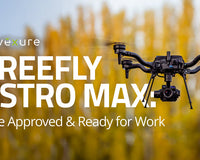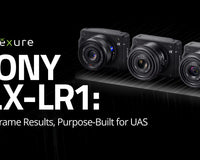On January 9, 2025, a drone launched by Peter Akemann collided with a Canadian‑built “Super Scooper” water‑bomber aircraft engaged in wildfire suppression above the Palisades Fire near Los Angeles. The impact punched a roughly 3x6‑inch hole in the aircraft’s left wing, forcing it out of commission for several days during active firefighting efforts.
This event illustrates a pressing concern for public‑safety professionals and critical‑infrastructure security teams: the national airspace is only getting busier and busier.
Authorized first responders, unmanned systems, and otherwise benign consumer drones all share the same sky. When a drone enters without awareness, the consequences can be severe.

For teams responsible for public safety response, firefighting missions, search and rescue operations, or security for airports, prisons, or large-scale events, the question is no longer IF something will fly overhead, but rather: who is it, what are they flying, and what trajectory are they on?
That is where Remote ID Receivers become a vital tool. As you deploy drones, counter‑UAS measures or manage airspace during high‑stakes incidents, the ability to detect, identify and monitor other unmanned systems in real time shifts from a “nice to have” to essential. In this blog we’ll learn about remote ID receivers, how they operate, and then move into how remote ID receivers specifically empower situational awareness.
By the end of this article you will (1) understand what a Remote ID receiver is, (2) know how it operates at a high level, and (3) learn about five top receivers available on the market today. Let’s dive in.
What Is a Remote ID Receiver?

At its core, a Remote ID receiver is a device designed to capture the identification and telemetry data broadcast by unmanned aircraft, and turn those raw signals into actionable insight. In effect, it takes the “digital license plate” information being broadcasted by a drone and makes it visible to your team in real time.
For a quick refresher on how Remote ID works, you can refer back to our past blog on Remote ID here:
Remote ID Detection Systems: How They Help With Airspace Safety & Risk Mitigation
How It All Works
-
Drones subject to the Remote ID rule broadcast packets of data that include: a unique identifier, GPS‑location of the aircraft, altitude, velocity or heading, and often the ground station/pilot location.
-
The receiver listens passively (i.e., without transmitting) for those broadcasts. Once a signal is acquired, the device decodes the data and presents it (typically on a map or dashboard) so the user can see where the drone is, where it came from, and where the pilot is located on the ground.
-
This process transforms an “invisible” threat or unknown aircraft into something you can track: who is flying, where they are, and what path they are on.
Why It Matters for Situational Awareness
For public‑safety teams, infrastructure security, and large event security, the value of a Remote ID receiver lies less in checking regulatory boxes and more in real‑time operational awareness:
-
You gain visibility into all RID compliant drones flying near your site or mission area, friendly or unauthorized.
-
You can distinguish between a known, permitted drone (e.g., your UAS fleet) and an unknown or unsanctioned actor.
-
You can integrate pilot and aircraft location data into your incident‑response or security workflow, enabling faster intervention.
Important Considerations
While Remote ID receivers are a powerful tool, they come with practical limitations that your team should understand:
-
The system only detects drones that are broadcasting. A drone whose Remote ID function is disabled, spoofed, or non‑compliant may not be visible. In these situations, additional detection methods such as radar, visual detection systems, or ADS-B receivers may be helpful.
-
Range and performance vary based on terrain, antennas, interference, and environmental factors. A handheld receiver might work within a limited radius in dense urban terrain, while rooftop or tower‑mounted sensors will perform better over open ground.
-
A receiver is ONLY one layer in your airspace‑monitoring strategy, not a standalone solution.
Key Use Cases for Remote ID Detection
The value of a Remote ID receiver becomes most apparent in the field. Whether mounted to a vehicle, installed on a rooftop, or carried by a team, they provide a real-time snapshot of the airspace that helps operators respond faster and make smarter decisions.
Below are some of the most common use cases across public safety, critical infrastructure, and event security.
Wildfire Response and Emergency Operations
During large-scale disasters like wildfires, multiple agencies often deploy drones to assess damage, locate hotspots, and guide suppression efforts. At the same time, hobbyists or news media may launch drones to capture aerial footage, often without coordination.
A Remote ID receiver allows incident commanders to maintain visibility over all Remote ID-compliant aircraft in the area. It becomes easier to confirm who’s operating legally, identify any unaccounted-for drones, and deconflict airspace before they pose a hazard to crewed aircraft.
Law Enforcement and Tactical Support
In the context of DFR, SAR, crime scene surveillance, or SWAT support, law enforcement agencies are increasingly relying on drones as force multipliers. However, in dense urban areas or high-profile incidents, it is not uncommon for outside drones to appear overhead.
Deploying a RID receiver gives tactical teams a clearer picture of the airspace. It helps distinguish between allied aircraft and uncoordinated or suspicious activity.
Correctional Facilities and Perimeter Security
Correctional institutions remain one of the most targeted sectors for drone-based contraband drops. Whether it’s drugs, weapons, or phones, the tactic is often the same: drop the payload from above and disappear.
A fixed-position Remote ID receiver, placed on the facility’s rooftop or security tower, offers a passive and persistent method to detect incoming aircraft that are broadcasting Remote ID. While not all threat actors will comply, many do, either out of ignorance or because they assume no one is watching.
Airports and Aviation Security
Airports face a uniquely high-stakes challenge when it comes to drone incursions. Even a small consumer drone flying near a runway can halt flight operations, trigger airspace shutdowns, or cause near-miss incidents with crewed aircraft. While many airports already deploy visual observers or radar-based systems, Remote ID receivers add another critical layer of detection.
With a Remote ID receiver installed near control towers, approach paths, or security perimeters, airport operations teams can immediately determine whether a drone is compliant, who is flying it, and where the pilot is located.
Remote ID receivers can also integrate into broader C-UAS platforms, feeding data to centralized security dashboards or alerting tower staff when an unknown aircraft crosses the threshold.
Large Crowd Events and Temporary Flight Restrictions (TFRs)
Stadiums, political rallies, protests, and parades often create complex security environments. Many of these events fall under TFRs, but that rarely stops drone pilots from taking to the sky.
Mobile Remote ID receivers, deployed in tactical vehicles, near command posts, or at elevated positions, can help event security monitor for active drones in the vicinity. This is especially important when multiple agencies are operating simultaneously or when high-level security coordination is required.
What to Evaluate When Choosing a Remote ID Receiver
There is no one-size-fits-all Remote ID receiver. The right choice depends entirely on how your team operates, the environments you work in, and what kind of visibility you need. Instead of listing off specs, let’s look at the questions you should ask when evaluating a system:
Where will this receiver actually live?
Start with deployment. Will this receiver be used in a fixed location like a prison rooftop, or do you need something mobile that can ride in a patrol vehicle or sit on a folding tripod during a wildfire?
Some receivers are plug-and-play with LTE and battery options, while others require fixed power and ethernet. Think about where this device will operate, and for how long, before narrowing your search.
How much range do you realistically need?
The specs might say “up to 5 miles,” but in practice, performance depends on the environment. Urban clutter, heavy RF traffic, or tree cover can all reduce range significantly.
If your mission demands wide-area coverage, you may need multiple receivers or elevated mounting points. For smaller sites, a single well-placed unit may be enough.
What happens after a drone is detected?
Detection is just the beginning. Ask how the system communicates what it sees. Does it display pilot and drone positions on a live map? Can you set alerts for restricted zones or unknown IDs? Does the data flow into a dashboard your team already uses?
The more seamlessly the receiver fits into your situational workflow, the more effective it becomes.
Can it store data for later?
Real-time visibility is critical, but so is historical accountability. If you need to log incidents, support investigations, or pull data post-event, make sure the system supports data logging.
Some receivers can archive flight traces, pilot IDs, and timestamps locally. Others may require cloud access or offer limited retention.
What are your power and connectivity options?
Field conditions vary. Maybe you’ll have access to power and ethernet. Maybe not.
If you’re deploying in remote areas or during fast-moving operations, you’ll want flexible power options (internal battery, swappable cells, PoE, or vehicle integration) and reliable connectivity (local UI, LTE, or Wi-Fi). The more adaptable the system, the more use cases it can support.
Can it scale with your mission?
Today, you might only need to cover one area or monitor one event. But what about six months from now? Look for systems that can grow with your needs, whether that means multi-sensor networks, broader protocol support, or integration with command software.
Top Remote ID Receivers for Airspace Monitoring
Each of the following Remote ID receivers meets current FAA broadcast detection standards and is built for situational awareness across a variety of deployment scenarios.
Dronetag RIDER

A compact, field-ready Remote ID receiver designed for tactical mobility and rapid deployment. Dronetag RIDER captures Remote ID signals from all compliant drones within a 3-mile radius, then pushes live telemetry to a companion app or UTM interface. Its rugged, IP54-rated housing and 6–10 hour battery life make it a solid choice for patrol officers, SAR teams, or security personnel operating on foot or in-vehicle.
Key Features
-
Detects Broadcast/Direct Remote ID signals via 2.4 GHz Bluetooth & Wi-Fi
-
3-mile (5 km) range with supplied high-gain antenna
-
LTE, Bluetooth, and USB-C data pathways
-
1,000 mAh Li-Po battery with 6–10 hours of scanning time
-
Compact: 5.3 × 2.1 × 0.8 in; 2.3 oz (IP54-rated enclosure)
-
Operates from -4 °F to 140 °F
-
Compatible with Drone Scanner app, local logging, or third-party integrations
Dronetag SCOUT

A robust, scalable Remote ID receiver designed for long-range detection and wide-area coverage. SCOUT supports multiple operation modes, including on-premise, cloud-based, and sensor-only configurations, and can integrate with existing C-UAS or airspace management systems. With directional antenna upgrades, detection range can extend to 15 miles in optimal conditions.
Key Features
-
Dual 2.4 GHz receivers (Bluetooth 4 & 5; Wi-Fi Beacon & NAN)
-
Detects drones up to 15 miles (25 km) with directional antennas
-
Operates in four modes: Sensor, Sensor+, Cloud, or On-Premise
-
PoE-powered with optional internal 4G/LTE modem
-
Rugged IP67/NEMA-6 enclosure with passive cooling
-
Wall or pole mount with included hardware
-
REST API and MQTT/JSON output for custom integrations
UAS Sentry

Designed for flexible deployments, UAS Sentry offers real-time drone and pilot detection with strong alerting and tracking capabilities. Its PoE or PoE+LTE configurations support both permanent installations and mobile use in vehicles or temporary command centers. Data can be accessed locally or through a secure cloud interface, enabling real-time visibility and post-incident analysis.
Key Features
-
Broadcast Remote ID detection across 2.4/5.8 GHz bands
-
BVLOS detection range up to 4 miles, terrain-dependent
-
Dual LTE connectivity, Wi-Fi, and Ethernet
-
IP67-rated housing for permanent outdoor install
-
External Type-N antennas with optional extensions up to 150 ft
-
Real-time alerts, map tracking, and secure historical storage
-
Included 1-year cellular data plan (configurable)
BlueMark DroneScout DS230

A cost-effective, NDAA-compliant Remote ID receiver built for integration and flexibility. The DS230 supports all major Remote ID signal formats (including Bluetooth, Wi-Fi NAN, and Wi-Fi Beacon) across the 2.4, 5.2, and 5.8 GHz bands. Designed for system integrators and C-UAS developers, it streams data in MQTT/JSON format for easy use with custom dashboards or open-source visualization tools.
Key Features
-
Short-range Remote ID receiver (≈5 km radius / 80 km² coverage)
-
Multi-band reception: Bluetooth 2.4 GHz, Wi-Fi 2.4/5.2/5.8 GHz
-
PoE (802.3af/at) with <5 W power draw
-
Open Drone ID framework with MQTT data stream
-
IP67 weather-resistant plastic enclosure
-
Dimensions: 27.2 × 27.6 × 9.6 cm, 1.4 kg
-
Mast/wall mount hardware included
AeroDefense AirWarden

AirWarden is an enterprise-grade receiver system designed for continuous monitoring of large facilities, campuses, and restricted zones. It captures Remote ID broadcasts across multiple bands and can scale to cover wide geographic areas through multiple units. Data is updated every second and can be streamed via Ethernet or LTE for real-time awareness and archiving.
Key Features
-
Detects FAA-compliant Remote ID broadcasts on 2.4 and 5.8 GHz
-
Detection range varies from 1–32 km depending on interference and elevation
-
LTE and Ethernet connectivity with ~15W power draw
-
Accuracy typically under 5 meters
-
Unlimited concurrent target detection
-
10” × 8.25” × 3.25” polycarbonate housing, 5 lbs
-
Pole-mount installation with flexible orientation
-
No ongoing hardware maintenance; firmware updates over the air
An Increasingly Crowded Airspace

Remote ID receivers are quickly becoming an operational necessity for public safety, critical infrastructure, and airspace security teams. They give real-time visibility into what’s flying overhead, where it came from, and who is operating it. In high-stakes environments having that visibility means faster response times, safer operations, and stronger coordination between agencies.
As the airspace continues to evolve and more unmanned systems take flight, the ability to detect, identify, and monitor nearby drones is no longer optional. It’s a core component of airspace awareness and risk management.
For agencies and organizations exploring how to integrate Remote ID receivers into their operations, Advexure’s team of UAS experts is ready to help you evaluate your options and identify the right solutions for your needs. Connect with our enterprise sales team or request a quote today.










